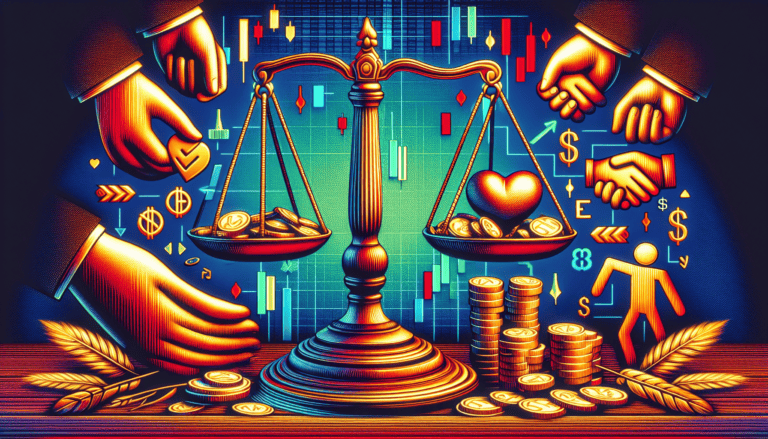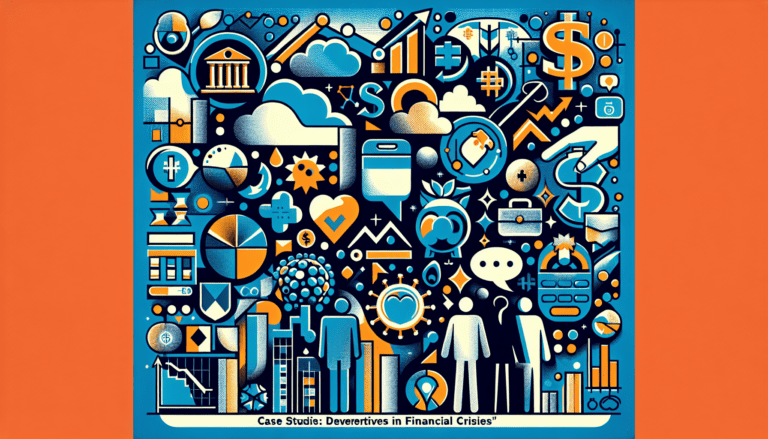Demystifying Credit Derivatives and Default Swaps: A Beginners Guide

Introduction to Derivatives Markets
The derivatives market represents an essential segment of the financial world, providing instruments that can be pivotal for investment strategies, risk management, and market efficiency.
What Are Derivatives?
Derivatives are financial contracts whose value is linked to the performance of an underlying asset, index, or rate. These instruments allow traders and investors to hedge against fluctuations, speculate on future movements of assets, or arbitrage price discrepancies between different markets. Common underlying instruments include stocks, bonds, commodities, currencies, interest rates, and market indexes.
Some of the most well-known forms of derivatives include futures, options, swaps (including credit derivatives and default swaps), and forwards. Each derivative has its own characteristics and usage in financial practices, accommodating a range of strategies from conservative risk aversion to aggressive speculation.
Role in Financial Markets
Derivatives are integral to financial markets for several reasons:
-
Risk Management: Derivatives provide tools for investors and businesses to safeguard against price volatility and unforeseen market movements. For instance, an investor can use options contracts to protect against a decline in stock prices.
-
Price Discovery: These financial instruments help determine the future price of an asset, contributing to market transparency and efficiency.
-
Access to Diverse Markets: Derivatives offer exposure to a variety of assets without the need to directly purchase the underlying instrument.
-
Liquidity: They inject liquidity into the financial system, allowing for the free flow of capital and the ease of entering and exiting positions.
-
Innovation and Tailored Strategies: The flexibility of derivatives enables the creation of customized solutions to fit specific investment goals or risk profiles, contributing to the innovation in derivatives markets.
The significance of derivatives is highlighted by their global reach and the volume of trading. They are traded across various platforms and institutions, from specialized derivatives exchanges to over-the-counter (OTC) markets, engaging a diverse array of participants including individual investors, financial institutions, corporations, and governments.
The derivatives market has witnessed substantial growth, propelled by demand for sophisticated risk management approaches and the advent of financial innovation. This expansion is a testament to the market’s ability to evolve and cater to the changing needs of the financial environment.
For a deeper dive into the structure and participants of the derivatives market, the derivatives market structure and participants article offers valuable insights. Additionally, understanding the regulatory framework for derivatives trading is crucial for comprehending how these financial instruments are governed to ensure market integrity and investor protection.
Understanding Credit Derivatives
Credit derivatives represent a sophisticated area within the financial markets, offering a range of instruments designed for managing credit risk. They serve as essential tools for investors and financial institutions to mitigate potential losses from defaults on debt instruments.
Basics of Credit Derivatives
Credit derivatives are financial agreements that allow an individual or entity to handle the credit risk of an asset or counterparty without necessarily owning the asset itself. These instruments are typically traded over-the-counter (OTC) and can be tailored to meet the particular needs of the transacting parties. As outlined by Investopedia, they enable the transfer or assumption of credit risk, which can pertain to various financial products such as bonds or loans.
One of the primary purposes of credit derivatives is to hedge against the likelihood of default. This process involves the seller assuming a degree of credit risk from the buyer. In exchange for this risk transfer, the seller receives periodic payments. Conversely, should a credit event such as a default occur, the seller is obliged to compensate the buyer.
Another application of credit derivatives is speculation. Investors may use these instruments to bet on the future direction of a debtor’s creditworthiness, thereby potentially realizing profits from fluctuations in credit risk levels.
Types of Credit Derivatives
There are several kinds of credit derivatives, each with unique mechanisms and purposes. The two principal types are credit default swaps (CDS) and total return swaps (TRS).
-
Credit Default Swaps (CDS): These are the most prevalent form of credit derivatives and function similarly to insurance policies. They provide protection against the default of a particular debt obligation. When an investor purchases a CDS, they are essentially buying protection against specific credit risks associated with a debt issuer. In the event of a default, the seller of the CDS compensates the buyer Investopedia.
-
Total Return Swaps (TRS): With TRS, the total return of a reference asset is exchanged between parties. One party receives the total return generated by the asset, which includes income and capital gains, while the other party pays a set rate, usually a fixed or floating interest rate. This setup allows investors to gain exposure to an asset’s return without actually owning it WallStreetMojo.
The following table provides an overview of these types of credit derivatives:
| Type | Description | Function |
|---|---|---|
| CDS | Acts as insurance against default | Transfers credit risk from buyer to seller |
| TRS | Swaps the total return of an asset | Provides exposure to asset return without ownership |
As investors delve further into the world of derivatives, they may also encounter other forms, including equity derivatives, commodity derivatives, and various exotic derivatives. Understanding these instruments can be critical for effective risk management and developing comprehensive hedging strategies.
For those new to derivatives markets, it’s beneficial to start with foundational knowledge, such as understanding futures contracts and exploring options trading, before advancing to more complex topics like credit derivatives and default swaps.
Focus on Credit Default Swaps
Credit default swaps (CDS) represent one of the most prevalent forms of credit derivatives in the financial markets today. They serve as a means of transferring credit exposure and managing potential risks associated with credit events.
Function of Credit Default Swaps
A credit default swap is essentially an insurance policy on the default risk of a corporate or government bond or loan. In a CDS agreement, the buyer makes periodic payments—often referred to as ‘premiums’ or ‘spreads’—to the seller. In return, the seller agrees to compensate the buyer in the event of a default or other credit incident concerning a third-party debt instrument, known as the ‘reference entity’ or ‘reference asset’ (Wikipedia).
The functions of CDS are twofold: they allow for the management of credit risk and enable market participants to speculate on the creditworthiness of reference entities. While originally intended as a tool for risk management, CDS can also be used for speculative purposes, allowing investors to bet on the likelihood of a default occurring without owning the actual debt instrument (PIMCO).
Parties Involved in CDS Transactions
In a typical CDS transaction, there are two primary parties:
- Protection Buyer: The buyer of the CDS, who seeks to hedge against the risk of default on a debt instrument they may or may not own.
- Protection Seller: The seller of the CDS, who guarantees the credit risk in exchange for periodic payments from the buyer.
Additionally, there may be other parties involved indirectly, such as brokers and market makers who facilitate the transactions, and clearinghouses that may act as intermediaries to reduce counterparty risk.
| Party | Role in CDS Transaction |
|---|---|
| Protection Buyer | Pays a premium to transfer the risk of default. |
| Protection Seller | Receives premium and assumes the risk of default. |
| Broker/Market Maker | Facilitates the CDS trade between the buyer and seller. |
| Clearinghouse | Acts as an intermediary to mitigate counterparty risk. |
Understanding the roles and responsibilities of each party involved in a CDS transaction is crucial for anyone interested in exploring the world of credit derivatives and default swaps. For those new to derivatives, it may also be beneficial to gain foundational knowledge on other derivative instruments such as futures, options, and equity derivatives.
Credit default swaps have played a significant role in the financial markets, and their impact has been felt in various market conditions, most notably during the financial crisis of 2007-2008 (Investopedia). As such, they have become a focal point for discussions on risk management with derivatives and the need for a robust regulatory framework.
Risks and Benefits of CDS
Credit derivatives and default swaps, particularly Credit Default Swaps (CDS), are financial instruments that play pivotal roles in the investment world. They offer mechanisms for risk management but also carry with them inherent risks.
Hedging vs. Speculation
The primary benefit of CDS is their use in hedging credit risks. A CDS allows an investor to offset potential losses from a credit event, such as a default on a loan or bond. This is akin to an insurance policy where the buyer of the CDS makes regular payments to a seller and, in return, receives a payoff if the underlying financial instrument defaults Investopedia.
However, CDS can also be used for speculation. Investors may use CDS to bet on the creditworthiness of an entity without owning the underlying asset. Here, the focus is on trading the risk of default and earning profits from fluctuations in credit spreads Investopedia.
| Purpose | Hedging | Speculation |
|---|---|---|
| Goal | Mitigate potential losses | Profit from risk |
| Relationship to Asset | Protection on owned asset | No ownership required |
| Risk | Premiums paid | Potentially unlimited losses |
Impact on Financial Stability
CDS can both enhance and threaten financial stability. On one hand, by allowing the transfer of credit risk, they can help disperse risk throughout the financial system and contribute to market stability WallStreetMojo. On the other hand, the misuse of CDS, particularly through speculation, can amplify risks.
The risks associated with CDS include:
- Counterparty Risk: The risk that the seller of the CDS is unable to fulfill their obligation.
- Market Risk: The risk of losses due to changes in the market value of the CDS.
- Credit Event Risk: The risk that the reference entity will experience a credit event, triggering a payout.
- Liquidity Risk: The risk that the CDS cannot be sold quickly at a fair price.
These risks came to a head during the financial crisis of 2007-2008, where the interconnected nature of CDS transactions amplified the impact of defaults Investopedia. Lehman Brothers’ collapse demonstrated the systemic risk posed by the CDS market when many institutions found themselves exposed to significant losses Investopedia.
The post-crisis reforms aimed to enhance transparency and reduce systemic risks. Regulations now require standardized CDS contracts to be traded on exchanges or electronic platforms Investopedia. This move towards greater oversight is designed to prevent the kind of widespread financial instability witnessed during the crisis.
Understanding the risks and benefits of CDS is crucial for beginner investors. While they are valuable tools for hedging strategies using derivatives, they require careful consideration and a grasp of their potential impact on financial stability. It’s important for investors to stay informed about the regulatory landscape for CDS to navigate these markets effectively.
Credit Derivatives and Financial Crises
Credit derivatives, particularly credit default swaps (CDS), have played a notable role in the financial markets. However, their impact on financial crises, especially the 2007-2008 financial turmoil, has been a subject of intense scrutiny and regulatory reform.
CDS Market Growth and Challenges
The market for credit default swaps saw exponential growth in the years leading up to the 2007-2008 financial crisis. With a market size of $920.7 billion in December 2002, it ballooned to over $62 trillion by the end of 2007 (Investopedia). This growth trajectory highlights the burgeoning demand for credit risk management solutions among financial institutions.
The CDS market’s challenges became particularly evident during the financial crisis. Credit default swaps were significantly implicated in the collapse of Lehman Brothers, as their interconnected nature magnified the default’s impact, leading to far-reaching financial instability (Investopedia). The sheer volume of the market and the opaqueness of these over-the-counter (OTC) instruments led to a situation where the risks were not fully understood, even by seasoned market participants.
| Year | CDS Market Size (Trillion USD) |
|---|---|
| 2002 | 0.92 |
| 2007 | 62+ |
Reforms Post-2008 Crisis
In response to the financial crisis and the role played by credit derivatives and default swaps, regulatory bodies worldwide implemented a series of reforms designed to enhance transparency and reduce systemic risk in the derivatives markets. One such measure was the push towards central clearing, which aimed to mitigate counterparty risk and enhance market stability.
The reforms also included requirements for reporting and disclosure to improve transparency and allow regulators and market participants to better assess the risks involved in these transactions. For instance, the Dodd-Frank Act in the United States introduced sweeping changes to the financial regulatory environment, impacting how credit derivatives are traded and managed (WallStreetMojo).
These reforms are ongoing, as regulators continue to adapt to the evolving nature of financial markets. Innovations in trading technology and the rise of new platforms have also played a role in shaping the current landscape of credit derivatives trading (derivatives trading platforms and technology).
As the market moves forward, it is crucial for participants to remain informed about the regulatory framework for derivatives trading and the latest hedging strategies using derivatives. The lessons learned from past financial crises, including the role of credit derivatives and default swaps, are instrumental in developing a more robust and resilient financial system. For those interested in further exploring the impact of derivatives on past financial crises, our case studies: derivatives in financial crises provide detailed accounts and analyses.
Regulatory Landscape for CDS
Since the 2008 financial crisis, the regulatory landscape for credit derivatives and default swaps has undergone significant changes to enhance transparency and mitigate systemic risk. Key reforms have been aimed at standardizing and centralizing the trading and clearing of these complex financial instruments.
Transparency and Exchange Trading
One of the pivotal regulatory changes in the derivatives markets, including for credit default swaps (CDS), is the shift towards greater transparency. Post-crisis reforms mandated that standardized CDS contracts be traded on exchanges or electronic platforms, rather than exclusively over-the-counter (OTC), where deals were previously negotiated privately between parties. This move to public trading venues is designed to provide a clearer view of market activity to participants and regulators alike, thereby reducing the likelihood of market manipulation and enhancing price discovery.
| Regulation | Description |
|---|---|
| Dodd-Frank Wall Street Reform and Consumer Protection Act (2010) | Required the move of standardized derivative contracts onto regulated exchanges |
| European Market Infrastructure Regulation (EMIR) | Introduced similar requirements in the EU for derivative contracts to be cleared through central counterparties |
Sources: Investopedia, European Commission
The regulatory framework for derivatives trading now also includes the role of clearinghouses, which act as intermediaries between buyers and sellers, further reducing the credit risk associated with CDS transactions. For more information on the role of clearinghouses, readers are encouraged to explore the clearinghouses in derivatives markets.
Recent Changes and Effects
Recent changes in the regulatory landscape have materially impacted the CDS market. The requirement for exchange trading has made it easier to track the credit spread movements of investment-grade and high-yield CDS indices. For instance, a report noted a significant widening of the credit spread for investment-grade CDS from the end of 2017 to mid-2018, a trend attributed to a series of interest rate hikes by the Federal Reserve (BIS).
Furthermore, the demand for protection against corporate defaults, as indicated by net purchases of CDS, increased significantly at the end of 2017 and the beginning of 2018, underscoring the market’s sensitivity to economic and financial events that shape risk preferences (BIS).
| Period | Investment-Grade CDS Credit Spread | High-Yield CDS Credit Spread |
|---|---|---|
| End-2017 to Mid-2018 | Widened Significantly | Widened Substantially |
These developments reflect the market’s evolving risk appetite and concerns about future economic growth trajectories. For investors and regulators, such data underscore the importance of ongoing vigilance and adaptation to maintain market stability.
As the CDS market continues to evolve, so too does the regulatory environment, with authorities working to strike a balance between innovation and safety. For insights into the latest developments in derivatives markets and their regulation, readers may find value in exploring innovations in derivatives markets and the future of derivatives trading.





